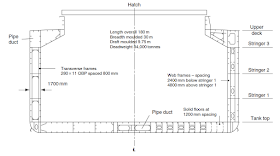With increasing prospects and demand for speed comes revolutionary changes in design and advancements in technologies. One such change which made a splash in the maritime industry was the introduction of X-bow by the Norwegian Ulstein Group. Since the inception of their first ship M/V Bourbon Orca in 2005 several other ship building yards/companies have used their design.
The X-bow comprises of a backward sloping bow starting at the extreme front of the vessel. This results in a continuous and smooth bow shape as shown below. Designing such a vessel involves proper weight distribution in the forward region which allows for submission and sharper bow shape. Increased volume up front allows it to efficiently respond to larger waves.
(M/V Bourbon Orca, image courtesy: Ulstein Group)
So, what are the factors that make X-bow better than the conventional? Let us see.
- Better comfort and efficiency - model tests by the Ulstein Group at MARIN revealed that the short duration of speed loss due to wave impact is almost negligible, giving the captain the confidence to sail at higher speeds.
- Lower level of vibrations.
- Lower resistance due to absence of flare.
- Better dynamic positioning due to lower wave-drift forces at zero speed compared to the conventional bow.
- Better deck capacity - due to better initial stability compared to conventional bow. Due to higher initial stability the deck load capacity is higher on X-bow.
- Reduced power consumption - the X-bow shape reduces pitch/heave accelerations and speed loss in waves, which renders higher speed transit and reduced power consumption.
- Reduced emissions - reduced fuel consumption leads to improved fuel efficiency hence, reduces emissions to air.
 |
| (Model test comparison of the X-bow and a Conventional bow shows the impact of wave on their respective bows, Image Courtesy: Ulstein Group) |
Also, the conventional bow has a forward sloping bow shape as a result the actual start of bow at the waterline is moved back. This design pushes the wave down and forward causing the vessel to slow down due to absorption of energy.
Construction of X-bow is much easier and is less resource intensive compared to the conventional bow. During the construction of the X-bow the following analysis was made -
- Labour costs was reduced by 15% in comparison to the conventional bulbous bow construction cost.
- Cost of assembly, welding, bending & rigging was cut by more than 50%.
- Adjustment and fitting works were reduced by 15% due to simplified forms of outer shell butt joints.
Model testing constitutes a very small part of the analyses, whenever there is a significant change in the design of the hull CFD analyses is often required. The following analyses were carried out by Ulstein Group -
- Hull resistance & optimization.
- Moon-pool effects - since X-bows are often used in the offshore industry, moon-pool operability plays a very major role. Using CFD free surface motions as well as added drag due to moon-pool can be predicted easily.
- Thruster and head-box alignment - flow around the propulsion systems contribute to about 4 - 5% of the power consumption, hence proper analyses should be done to minimize its effect.
- Self - propulsion.
- Sea-keeping simulations - for offshore vessels, sea-keeping performances are often given more importance than calm-water performances.
- Wind effects.
 |
| (CFD analyses, image courtesy: Ulstein Group) |
The concept of inverted bows prevailed during the early 20th Century however they faded away due to lack of efficiency. But, with the introduction of Ulstein Groups X-bow design it has made a come back and is not only limited to the offshore industry but is also used in naval vessels and various pleasure yachts and it will soon be introduced in the container ship market.LSD
Article by: Tanumoy Sinha.
Recommended readings:






















.jpg)
.jpg)

.jpg)

